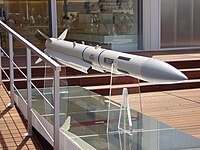
Photo from wikipedia
Research on the water-to-land transition tends to focus on the locomotor changes necessary for terrestriality. But the evolution from water breathing to air breathing was also a necessary precursor to… Click to show full abstract
Research on the water-to-land transition tends to focus on the locomotor changes necessary for terrestriality. But the evolution from water breathing to air breathing was also a necessary precursor to the invasion of land. Air is approximately 1,000 times less dense, 50 times less viscous, and contains hundreds of times more oxygen than water. However, unlike the transition to terrestrial locomotion, breathing air does not require body weight support, so the evolution of air breathing may have necessitated smaller changes to morphology and function. We used X-ray Reconstruction of Moving Morphology to compare the cranial kinematics of aquatic buccal pumping, such as seen in suction feeding, with the aerial buccal pumping required for lung ventilation in the West African lungfish (Protopterus annectens). During buccal pumping behaviors, the cranial bones and associated soft tissues act as valves and pumps, and the sequence of their motions controls the pattern of fluid flow. Both behaviors are characterized by an anterior-to-posterior wave of expansion and an anterior-to-posterior wave of compression. We found that the pectoral girdle and cranial rib rotate consistently during air breathing and suction feeding, and that the muscle between them shortens during buccal expansion. Overall, we conclude that the major cranial bones maintain the same basic functions (i.e., acting as valves or pumps, or transmitting power) across aquatic and aerial buccal pumping. The cranial morphology that enables aquatic buccal pumping is well-suited to perform air-breathing and accommodates the physical differences between air and water.
Journal Title: Integrative and comparative biology
Year Published: 2022
Link to full text (if available)
Share on Social Media: Sign Up to like & get
recommendations!